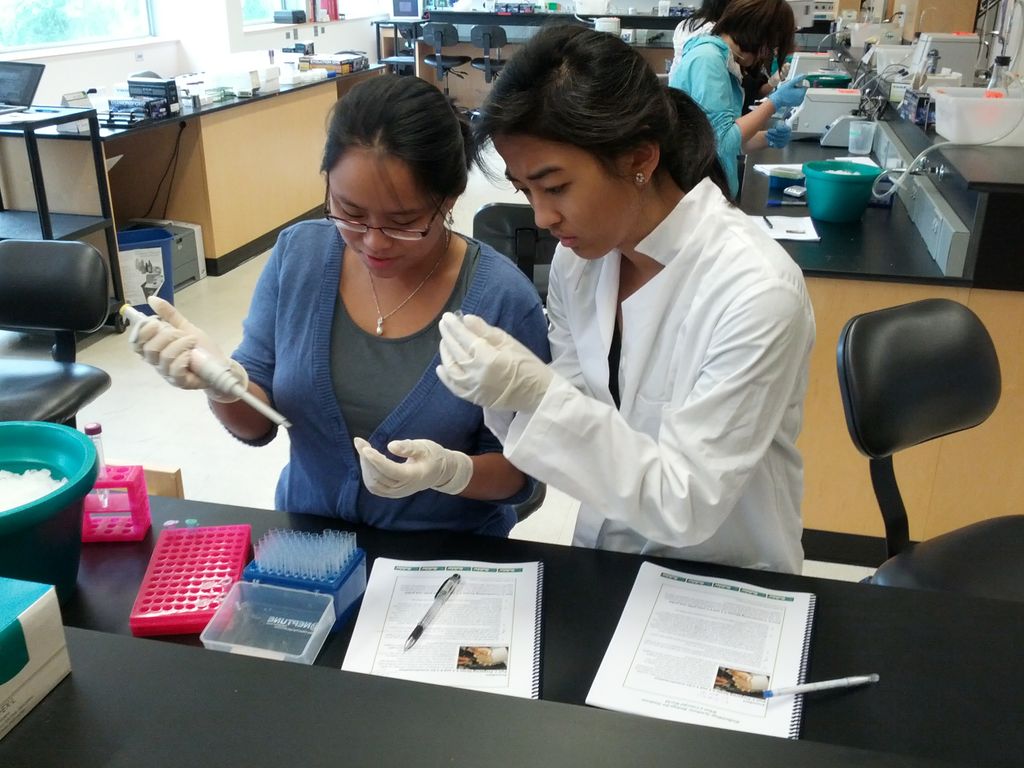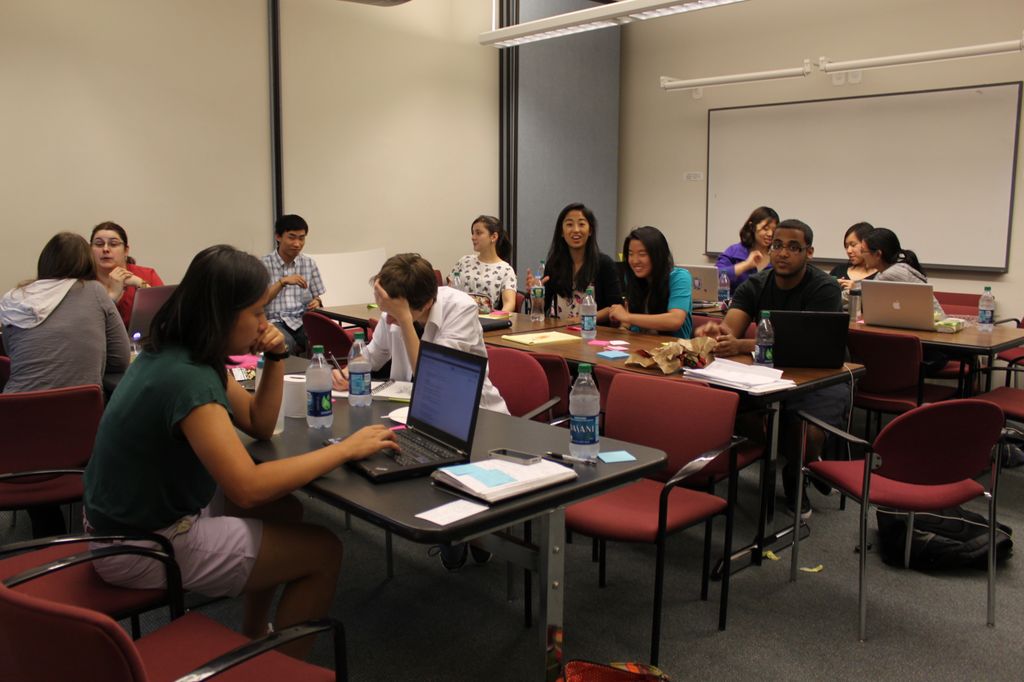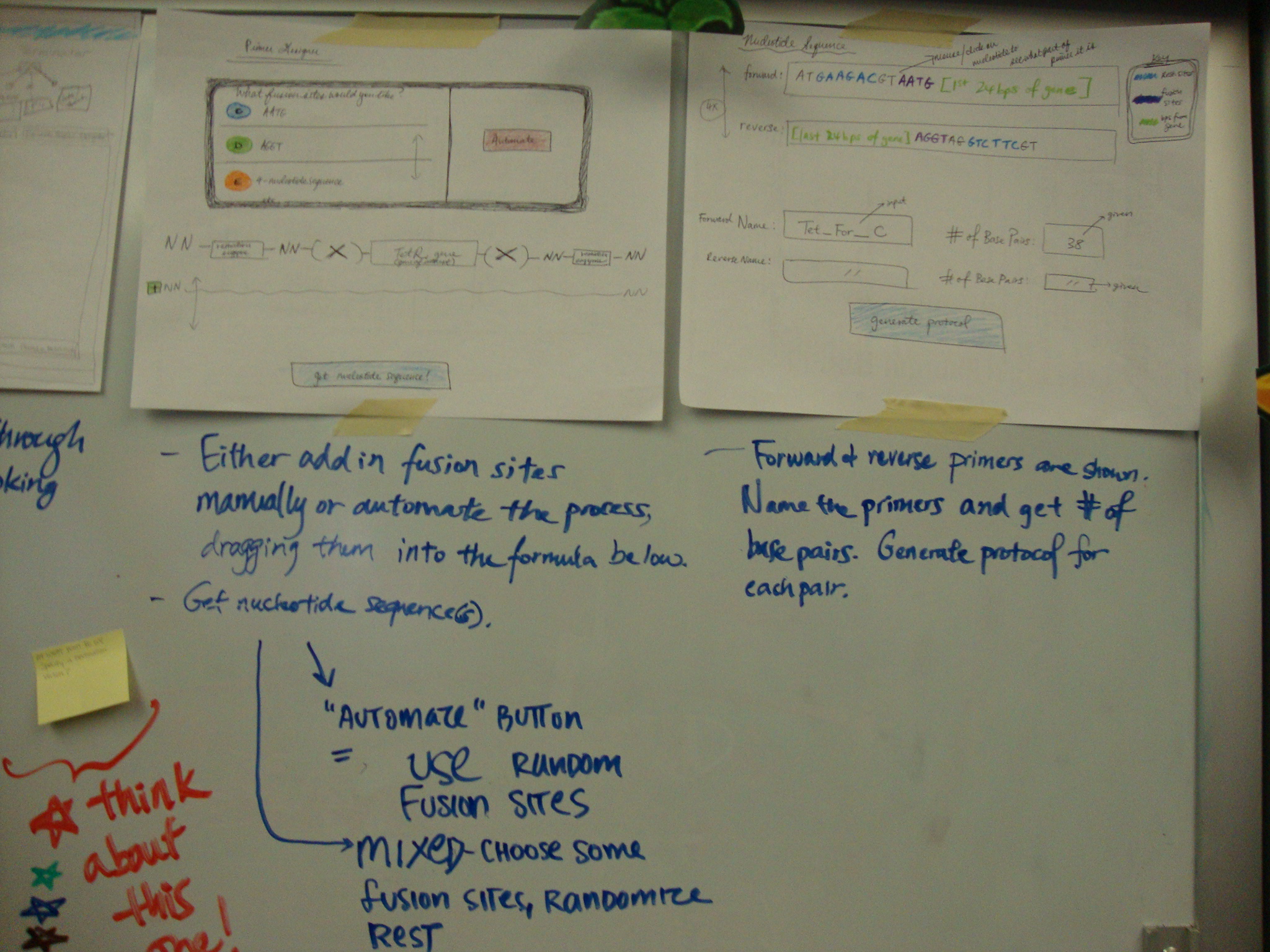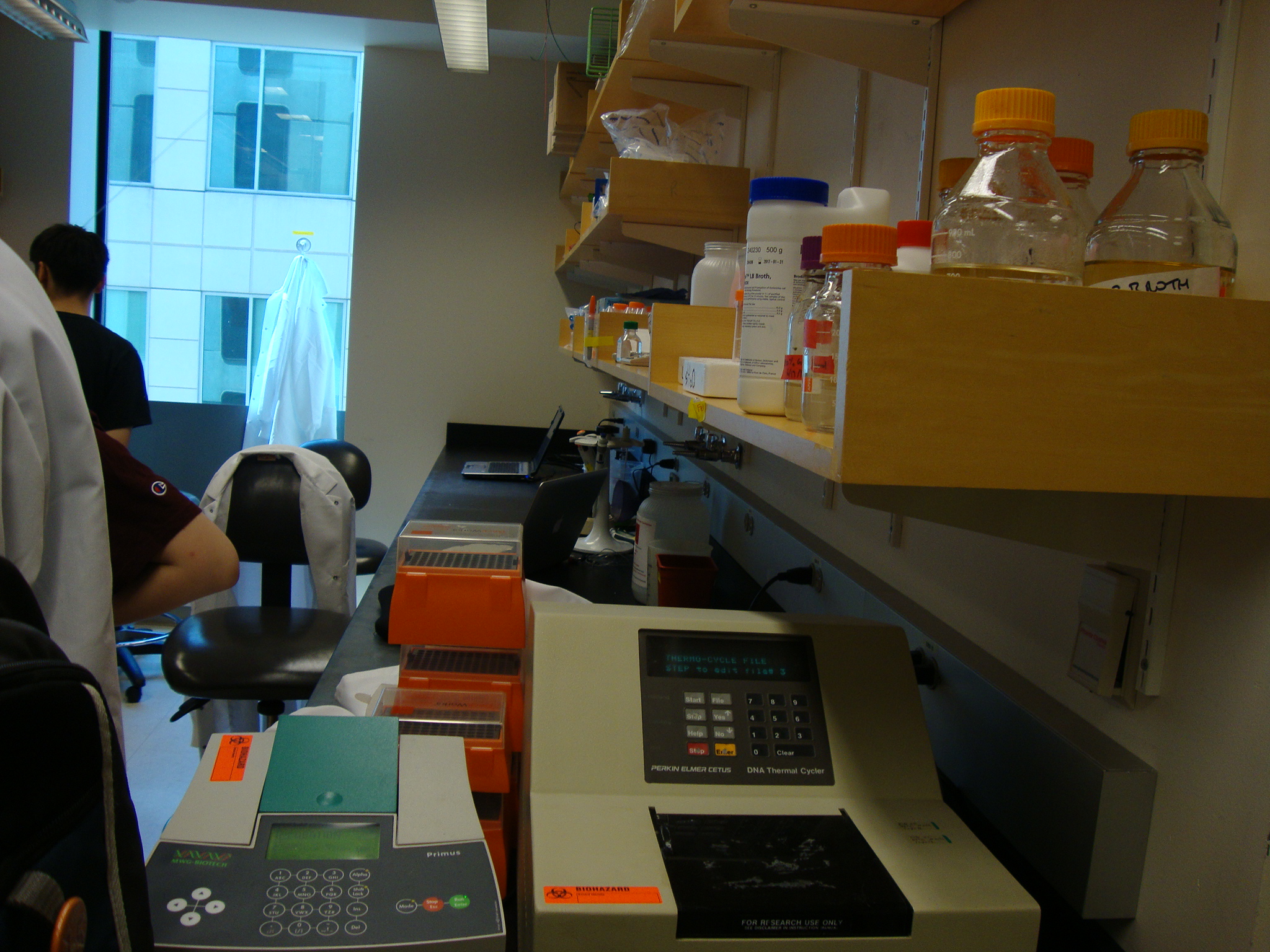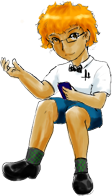Team:Wellesley HCI/Notebook/SiruiNotebook
From 2012.igem.org
(Difference between revisions)
(→Week of June 4th) |
(→Week of June 4th) |
||
| Line 140: | Line 140: | ||
[[File:Wetlab2.jpg|thumb|left| Casey and Linda working hard in the lab too!]] | [[File:Wetlab2.jpg|thumb|left| Casey and Linda working hard in the lab too!]] | ||
| - | *'''Wednesday, 6/6:''' Today my group- Kara, Nahum, and I- started working on a powerpoint presentation in preparation for the brainstorming meeting with Orit tomorrow. We are working on researching past research in development of ELNs, and dividing up functions based on modality. | + | *'''Wednesday, 6/6:''' Today my group- Kara, Nahum, and I- started working on a powerpoint presentation in preparation for the brainstorming meeting with Orit tomorrow. We are working on researching past research in development of ELNs, and dividing up functions based on modality. Casey and I are also looking up research related to microinteractions that can be performed on the beast. We are particularly interested in Sifteo cubes and PaperLens. |
| - | *'''Thursday, 6/7:''' | + | *'''Thursday, 6/7:''' Today we had a meeting with Orit on things we learned about the ELN, and presented to her in a format of a Powerpoint. Since this is a preview of things we will be presenting about on Monday, the meeting was rather short. Orit suggested that we focus more on things having to do with troubleshooting, and features that can be added to the ELN that deal with visualizing troubleshooting in the lab. |
| - | *'''Friday, 6/8:''' | + | *'''Friday, 6/8:''' Casey and I had a meeting with Orit today about microinteractions. Orit suggested that we look more into sifteo cubes as it might be used in the art project for the future, and that we should also focus on interactions that can be done on the bezel. A lot of the research that we thought weren't "feasible" might actually be more realistic than we previously thought- the beauty of HCI! |
| - | + | ||
| - | + | ||
| - | + | ||
== Week of June 12th == | == Week of June 12th == | ||
Revision as of 21:07, 15 July 2012
Kathy's Notebook
Contents |
Week of June 4th
- Monday, 6/4: Jumping right back into research, after so much background readings over the weekend! Today we went to the Microsoft Research Cambridge to get a tutorial of Windows 8. It was particularly interesting because I hadn't had contact with C# nor Visual Basic before, but only got a crash course on it this morning. The new UI was especially interesting, especially the new metro-apps style and the start menu style change. There were also a couple of new gestures that were used with the tablet, such as swiping to corners or gesture-based log-in, that were particularly interesting. It would be great if we could take all these innovations and put them in the ELN design as well.
- Tuesday, 6/5: Today the Wellesley team went to MIT for a basic wet-lab training with Prof. Natalie Kuldell, who used to teach Genetics/BISC 219 labs at Wellesley. Those unfamiliar with synthetic biology received an introduction to the field, and we watched a videotaped presentation from the MIT '06 iGEM team, to gain a better understanding of how the iGEM competition format worked. Also, we were given an extensive introduction to what is expected in the human practices portion of the iGEM competition, and another introduction on doing interdisciplinary research (the different perspectives between engineers and lab scientists).
- Even better, after that we were able to participate in two different basic wet labs, one that is based on the Eau d'Coli lab, and another lab in creating beta-galactosidase assays. My lab partner, Consuelo, and I both realized that the experience was immensely valuable and incredibly eye-opening.
- We both agreed that several factors led to efficient completion of an experiment: labelling, following instructions, and communicating. We ran into problem again and again when we repeatedly mislabeled the tubes and confused our reagents, forcing us to restart repeated. We also found it at times challenging to follow the instructions in the format they were written in, simply because while reactions were happening we didn't have time to both read multiple paragraphs and pipette every 15 seconds. The wet-lab experience was eye-opening, and made us realize if the ELN is to be implemented that several features, such as highlighting, and labeling tools, among many others, needed to be added.
- Wednesday, 6/6: Today my group- Kara, Nahum, and I- started working on a powerpoint presentation in preparation for the brainstorming meeting with Orit tomorrow. We are working on researching past research in development of ELNs, and dividing up functions based on modality. Casey and I are also looking up research related to microinteractions that can be performed on the beast. We are particularly interested in Sifteo cubes and PaperLens.
- Thursday, 6/7: Today we had a meeting with Orit on things we learned about the ELN, and presented to her in a format of a Powerpoint. Since this is a preview of things we will be presenting about on Monday, the meeting was rather short. Orit suggested that we focus more on things having to do with troubleshooting, and features that can be added to the ELN that deal with visualizing troubleshooting in the lab.
- Friday, 6/8: Casey and I had a meeting with Orit today about microinteractions. Orit suggested that we look more into sifteo cubes as it might be used in the art project for the future, and that we should also focus on interactions that can be done on the bezel. A lot of the research that we thought weren't "feasible" might actually be more realistic than we previously thought- the beauty of HCI!
Week of June 12th
Brainstorming week!! Powerpoints, what we are thinking about....
- Monday, 6/12: Visited BU today and finally met the wetlab members, Shawn and Monique. Did a presentation on the basics of HCI, and also did brainstorming for the development of the ELN. Also, we got a crashcourse on topics in biology to be covered this summer in the lab, as well as the MoClo method, which will be the main focus of the wetlab team this summer, as they will be using it to characterize parts.
- Tuesday, 6/13: Brainstorming day #1 at Wellesley---> pictures to follow
- Wednesday, 6/14: Brainstorming day #2 at Wellesley---> pictures to follow as well Theme of the summer: create tools that help synthetic biologists troubleshoot in the lab.
- Thursday, 6/15:
- Friday, 6/16: Interview with Professor Chris A. Thoughts to come....
Week of June 18th
- Monday, 6/18: Interview with prof. Sequiera--> thoughts? more to come..
- Tuesday, 6/19: Reading the MoClo paper; looking up background information on ELN, including the Butterfly paper.
- Wednesday, 6/20: same thing today as yesterday.
- Thursday, 6/21: paper prototyped the MoClo planner, and started to storyboard it. here's what the first panel looks like:
- Friday, 6/22: Transcribed the interview with Professor Sequiera. Talk about some trends and interesting things I've noticed in terms of bioethics and human practices.
Week of June 25th
- Monday, 6/25: Continuing interview transcriptions still. These things take an amazing amount of time.
- Also started paper prototyping and developing the transitions for the "shutter" design to be made into a video tomorrow.
- Tuesday, 6/26: Created a paper prototype video for the MoClo planner. The youtube link is: http://www.youtube.com/watch?v=IPr-D4vAGAM
MIGHT BE COOL IF I INSERTED A VIDEO HERE.
- Wednesday, 6/27: We got some feedback from Traci today on the design for the MoClo planner. She would also like us to include in the primer designer component the reverse complement sequence created for the reverse primer. Also, I guess we also forgot some really important information for primer designer that we included in the Optimus Primer design last year- stuff like checking for different kinds of dimers, secondary structures, melting temperatures, etc. We will have to add that for later.
Also, I started looking more into Eugene today.
- Thursday, 6/28: Continued looking more into Eugene and getting familiarized with the terminology. It seems that there is great flexibility in the language when it comes to syntax and definition.
- Friday, 6/29: We met the MIT 2012 iGEM team today, and had social hour with the BU team as well. We went to an interesting physics lecture talk by Professor Walter Lewin, which was taped by NHK, the Japanese national broadcasting station. Members of the team visited the MIT iGEM wet-lab. We'll be back to visit team meetings in the future as well!!
Week of July 2nd
- Monday, 7/2: Continued looking into Eugene, and reviewing the Optimus Primer code from last year. I'm anticipating getting into the nitty-gritty details of the coding soon!
- Tuesday, 7/3: Started working today on the rules and definitions needed to create a Level 1 module. This should be really interesting since I'm not familiar with C# nor Java nor Eugene yet. But I'm learning!
- Wednesday, 7/4: Happy 4th of July! Kim, Kara, and I saw "The Amazing Spider-Man". There was a very cool tree visualization in one of the scenes that could totally be applied to our troubleshooting tree. It's interested how a lot of the things mentioned are already feasible in the field of HCI. Even better? "Cross-species genetics"... synthetic biology?
- Thursday, 7/5: Finished the Level1 module rules for Eugene. Fiddling around with the C# code for displaying the permutations by referencing the primer designer code we were working with last year, but having some difficulties.
- Friday, 7/6: Sat down with Casey and slowly got introduced to the C# code for the Eugene module. Ran simulated data through Eugene and were able to make to print the codes in the command window. Next step: work on figuring out how product/permute works in the eugene code. Talked to Ernst; Eugene code will be updated soon, and we can view the sample code later.
To do for next week: Start parsing real data for feeding into the C# code, get Eugene to work, contact more PIs/post-grads/grads/profs for interviews on troubleshooting, start working on things for L2 module and primer designer with the background info Traci gave us, and contact other iGEM teams for observations/participation.
Week of July 9th
- Monday, 7/9: Consuelo, Casey, and I visited the MIT iGEM team and sat in on a morning wet-lab meeting today.
- Initial observations: Right away we noticed that one of the main problems was sharing of visual aid and lack of space, and how that affected the presentation styles of the students.
- Troubleshooting: we also looked at troubleshooting techniques, and noticed several trends.
- Also, we started using the product and permute functions on Eugene. It seems that product and permute do not actually work the way we want them to for Level 1 modules. We want variations of concrete parts in the same order, replacing the absDevice(prom, RBS, CDS, term) pattern with real biobrick parts. However, permute changes the order of the parts so that the absDevice would have variations of (RBS, prom, term, CDS) or (term, RBS, CDS, prom), etc on the inside. This function will be extremely useful once we get to creation of Level 2 modules, but it is not pertinent to creating Level 1 modules.
- Tuesday, 7/10: Started fiddling with parsing real data. Somehow it's really difficult retrieving RBS data from the Registry! Do you search "RBS", their family names, or something else all together? What if the RBS doesn't have a family it belongs in? Nicole and Veronica have been working on semantic search for a while, and used their skills to also mine the Registry for pertinent information for the MoClo planner. However, as a result of using different parameters to classify different backbone parts, the rules that I wrote earlier for Eugene must now all be redefined. For example, I realized today that instead of creating 4 separate categories of promoters (constitutive, hybrid, repressible, inducible) that the promoter type can just be defined as a property" of promoters inside of a promoter type. The same pattern can also be followed for RBS, CDS, and terminators.
- Wednesday, 7/11: Talking with the BU wetlab. More observation details and questions to follow.
- Thursday, 7/12: We worked on integrating my code with the front end done by Kara and Nahum. We decided that since permute nor product does what we thought they did, we should only use "permute" in Eugene for Level2 modules, and that for Level1 modules we create only a nested for-loop. Today I worked on integrating that into the MoClo Planner design, but as usual, ran into a lot of problems with syntax. We wanted to interview Professor Beers today, but there was a conflict and the interview is delayed to another time.
- Friday, 7/13: Starting to work on the backend behind Level 2, especially on Eugene. Things are especially interesting because creating a hybrid device might not work the way we thought in Eugene. So far, to test hybrid device functionality, we are creating four abstract devices with the same non-specific backbone parts, and then permuting them once they are all defined to be a single hybrid device. The problem is, will the permutations show the differences between the pieces of the hybrid device?
- So far, permutations are working- we can create 720 permutations of a level2 device from 6 abstract level 1 devices; this can be done by defining the abstract devices with the same parts inside (prom, RBS, CDS, term) while they are all abstract, and create a hybrid device composed of all 6 abstract devices. Then, the permutation is of the abstract devices inside the hybridDevice, which come out at 6!, or 720 permutations.
 "
"

